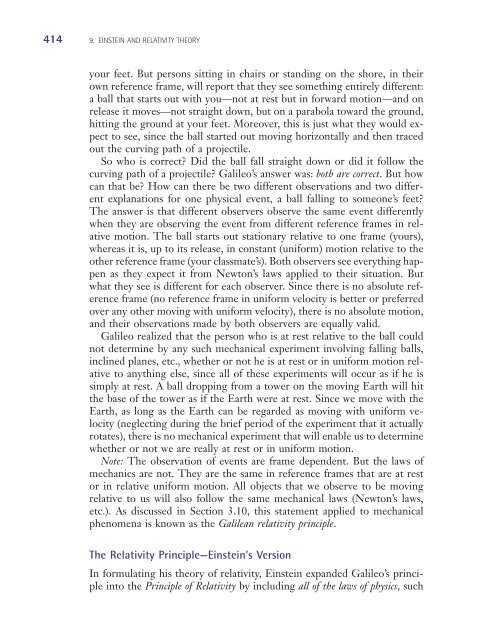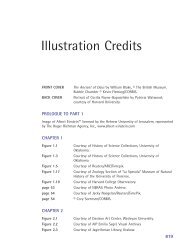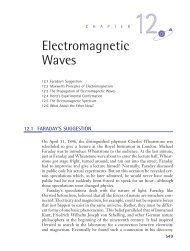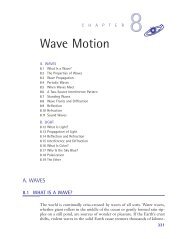Chapter 9: Einstein and Relativity Theory (319 KB) - D Cassidy Books
Chapter 9: Einstein and Relativity Theory (319 KB) - D Cassidy Books
Chapter 9: Einstein and Relativity Theory (319 KB) - D Cassidy Books
Create successful ePaper yourself
Turn your PDF publications into a flip-book with our unique Google optimized e-Paper software.
3637_<strong>Cassidy</strong>TX_09 6/14/02 12:08 PM Page 414<br />
414 9. EINSTEIN AND RELATIVITY THEORY<br />
your feet. But persons sitting in chairs or st<strong>and</strong>ing on the shore, in their<br />
own reference frame, will report that they see something entirely different:<br />
a ball that starts out with you—not at rest but in forward motion—<strong>and</strong> on<br />
release it moves—not straight down, but on a parabola toward the ground,<br />
hitting the ground at your feet. Moreover, this is just what they would expect<br />
to see, since the ball started out moving horizontally <strong>and</strong> then traced<br />
out the curving path of a projectile.<br />
So who is correct Did the ball fall straight down or did it follow the<br />
curving path of a projectile Galileo’s answer was: both are correct. But how<br />
can that be How can there be two different observations <strong>and</strong> two different<br />
explanations for one physical event, a ball falling to someone’s feet<br />
The answer is that different observers observe the same event differently<br />
when they are observing the event from different reference frames in relative<br />
motion. The ball starts out stationary relative to one frame (yours),<br />
whereas it is, up to its release, in constant (uniform) motion relative to the<br />
other reference frame (your classmate’s). Both observers see everything happen<br />
as they expect it from Newton’s laws applied to their situation. But<br />
what they see is different for each observer. Since there is no absolute reference<br />
frame (no reference frame in uniform velocity is better or preferred<br />
over any other moving with uniform velocity), there is no absolute motion,<br />
<strong>and</strong> their observations made by both observers are equally valid.<br />
Galileo realized that the person who is at rest relative to the ball could<br />
not determine by any such mechanical experiment involving falling balls,<br />
inclined planes, etc., whether or not he is at rest or in uniform motion relative<br />
to anything else, since all of these experiments will occur as if he is<br />
simply at rest. A ball dropping from a tower on the moving Earth will hit<br />
the base of the tower as if the Earth were at rest. Since we move with the<br />
Earth, as long as the Earth can be regarded as moving with uniform velocity<br />
(neglecting during the brief period of the experiment that it actually<br />
rotates), there is no mechanical experiment that will enable us to determine<br />
whether or not we are really at rest or in uniform motion.<br />
Note: The observation of events are frame dependent. But the laws of<br />
mechanics are not. They are the same in reference frames that are at rest<br />
or in relative uniform motion. All objects that we observe to be moving<br />
relative to us will also follow the same mechanical laws (Newton’s laws,<br />
etc.). As discussed in Section 3.10, this statement applied to mechanical<br />
phenomena is known as the Galilean relativity principle.<br />
The <strong>Relativity</strong> Principle—<strong>Einstein</strong>’s Version<br />
In formulating his theory of relativity, <strong>Einstein</strong> exp<strong>and</strong>ed Galileo’s principle<br />
into the Principle of <strong>Relativity</strong> by including all of the laws of physics, such






